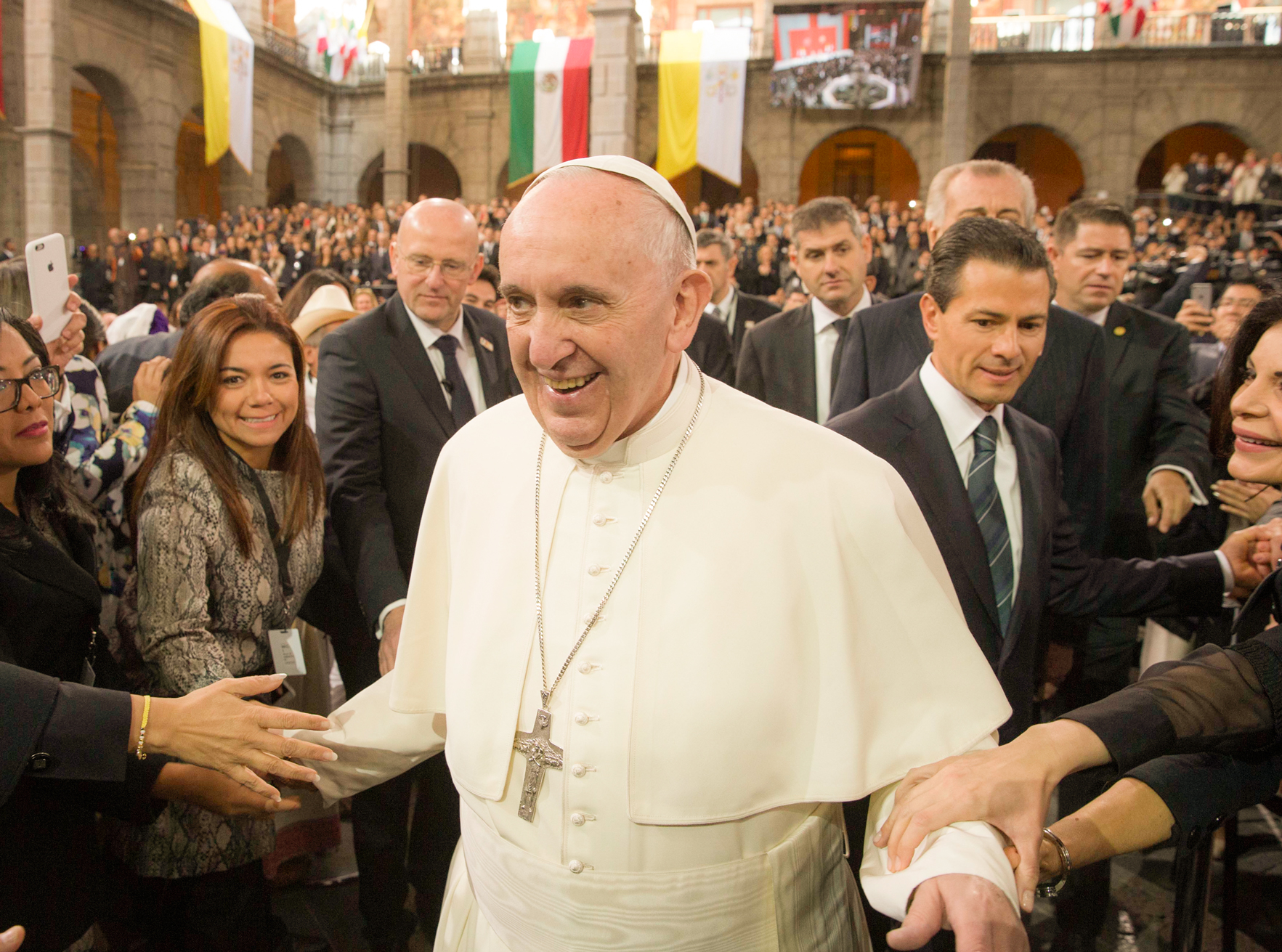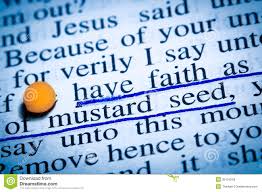
Before Pope Francis had even embarked on his just concluded journey to Mexico, Republican presidential candidate Donald Trump critically remarked that the pope is “a very political person.” Commenting on the pope’s planned Mass in Ciudad Juárez along the border with the United States, Trump opined, “I don’t think he understands the danger of the open border that we have with Mexico,” and he speculated that Francis was serving as a pawn of the Mexican government. As John Gehring has noted, Trump is right to see Francis’s visit to the border as political. But the Mass, and the entire apostolic journey to Mexico, was political precisely because it was focused on the proclamation of the Gospel.
Jesus’ birth was a political act. How else could the birth of a baby in a stable in a backwater town leave King Herod, the Romans’ puppet ruler of Judea, “greatly troubled” (Mt. 2:3)? What inspired Herod to massacre all the infants of Bethlehem (Mt. 2:16)? Ancient rumors that HaMashiach, God’s anointed one, the one who would “throw down the rulers from their thrones and lift up the lowly” (Lk. 1:52), led Herod to perceive the baby Jesus as a threat, prefiguring the course of Jesus’ ministry.
Jesus’ death was also a political act. Why would the Roman occupiers of Judea try, sentence, and execute a preacher of love and reconciliation? Jesus’ proclamation of the Kingdom of God was fundamentally political. Jesus tells Pontius Pilate, “My kingdom does not belong to this world” (Jn. 18:36), but this does not mean that the Kingdom is apolitical or unconcerned with the things of this world. Because this Kingdom has its authority from God rather than earthly authorities, it transcends the kingdoms of this world and stands in judgment over them. The way of Jesus involves discerning Jesus’ own face in the faces of the vulnerable (Mt. 25:31-46), a way of living that serves as a rebuke to the authorities of this world who “lord it over” others (Mt. 20:25), inviting hatred and at times violent persecution from the world (Jn. 15:18-25).
Through his resurrection from the dead, Jesus overcame death and all those authorities and powers that cause death (1 Cor. 15:20-28). The actions that defined Jesus’ ministry—feeding the hungry, healing the sick, curing the blind—show that “life according to the Spirit” (Rom. 8:1-13) does not neglect bodily life but rather makes it whole. Following Jesus is a political act of prophetic witness against death and in favor of life.
From its beginnings, Catholicism in Mexico has been political. The introduction of Catholicism to Mexico was intimately tied to the Spanish conquest and enslavement of the Aztecs and other indigenous peoples of the region in the sixteenth century. Tragically, the Gospel of Life had been yoked to the powers of death. Yet the Gospel has the power to bring life from death. When Our Lady of Guadalupe appeared to Juan Diego in 1531, she appeared indigenous like Juan, affirming that the faces of the Mother of God and of the child in her womb were the faces of the oppressed. Mary commanded Juan Diego to go to Archbishop Juan de Zumárraga in Mexico City to ask him to build a church in her honor, but the bishop was doubtful. After the miraculous appearance of Castilian roses and the image of Mary on Juan’s tilma, the bishop came to believe. The white, Spanish bishop had to be taught true worship by the indigenous Juan Diego. Here we see what the historian Justo González has called the two faces of Latin American Catholicism: one face that of the powers that be, often the oppressors of the weak, the other the face of the poor and marginalized.
In his homily at the Basilica of Our Lady of Guadalupe on February 13, Pope Francis appealed to the life-affirming significance of the apparition:
On that morning in December 1531, the first miracle occurred which would then be the living memory of all this Shrine protects. On that morning, at that meeting, God awakened the hope of his son Juan, and the hope of a People. On that morning, God roused the hope of the little ones, of the suffering, of those displaced or rejected, of all who feel they have no worthy place in these lands.
Francis then made clear the different ways that the Gospel continues to have political significance in Mexico today: “On that morning, God came close and still comes close to the suffering but resilient hearts of so many mothers, fathers, grandparents who have seen their children leaving, becoming lost or even being taken by criminals.” Here the pope is making a clear reference to the struggles of the Mexican people to which he responded throughout his journey.
Mexico’s 1917 constitution severely restricted the public role of the church: it gave the state ownership of religious buildings, forbade public religious assemblies, and forbade the clergy from addressing public affairs or even appearing in clerical dress in public. These laws were a response to the perceived dangers of both faces of Mexican Catholicism. Clearly the laws were meant to weaken the church’s traditional support for the conservative elites. But they also were an attempt to prevent Catholicism from becoming a rallying point for the masses against the new elites, as it had done on occasion throughout the nineteenth century (and would do so again during the Cristero War of 1926-29)..
Most of these legal restrictions on the church were removed in 1992, but Pope Francis’s address to government leaders at the National Palace, the most overtly political event of the trip, was still unprecedented in a country not used to church leaders taking a public role. In this speech the pope affirmed that the Catholic Church would accompany the Mexican people in building “political life on a truly human basis” (citing Gaudium et Spes). He noted the great potential of Mexico’s young people, but then turned to the dark shadows hanging over Mexican society: “corruption, drug trade, exclusion of different cultures, violence and also human trafficking, kidnapping and death.” His comments were a rebuke to the nation’s political leaders, including President Enrique Peña Nieto, who have failed to adequately address these problems because of their own corruption, fear of the drug cartels, and bureaucratic inertia.
On February 15, Pope Francis traveled to San Cristóbal de las Casas, in Chiapas state. The states of southern Mexico, including Chiapas, have the nation’s largest indigenous populations. As in other Latin American countries with large indigenous populations, such as Guatemala, Peru, and Bolivia, the indigenous cultures and languages of Mexico have historically been suppressed in the name of nationalism rooted in mestizo (mixed indigenous and white) identity. This cultural marginalization was closely linked to social and economic marginalization, and today Chiapas remains one of the poorest regions of Mexico.
Francis recognized this history in his homily at San Cristóbal de las Casas:
[O]n many occasions, in a systematic and organized way, your people have been misunderstood and excluded from society. Some have considered your values, culture and traditions to be inferior. Others, intoxicated by power, money and market trends, have stolen your lands or contaminated them.
As at Guadalupe, Francis proclaimed God’s accompaniment of the poor. Using the Exodus of the Israelites from Egypt as a parallel to the plight of the people of Chiapas, Francis claimed, “Here the true face of God is seen, the face of the Father who suffers as he sees the pain, mistreatment, and lack of justice for his children.” Just as Juan Diego taught the bishop true worship, Francis boldly asserted that the indigenous of Mexico “have much to teach us, much to teach humanity.” The poor themselves are the missionaries of the Gospel, even to those in authority, therefore subverting the normal order of politics.
The finale of Francis’s journey was the Mass in Ciudad Juárez, the plans for which had drawn Donald Trump’s ire (leading to some harsh words from Pope Francis in an interview on the plane ride back to Rome). As the Mass was being celebrated at the Juárez fairground, a crowd gathered across the border in El Paso, as well, and United States bishops Sean O’Malley, Jose Gomez, and Mark Seitz concelebrated the Mass with the pope. The celebration of the Eucharist served as a cross-border act of solidarity. In his homily, Francis appealed to the theme of his Year of Mercy:
To weep over injustice, to cry over corruption, to cry over oppression. These are tears that lead to transformation, that soften the heart; they are the tears that purify our gaze and enable us to see the cycle of sin into which very often we have sunk. They are tears that can sensitize our gaze and our attitude hardened and especially dormant in the face of another’s suffering. They are the tears that can break us, capable of opening us to conversion.
He called on all of us to see in immigrants the face of the suffering, to see them as “names, stories, families” instead of “numbers and statistics.” He implored, “No more death! No more exploitation!” Here we see echoed Jesus’ own prophetic witness against death and the institutions which cause it, and his identification with the faces of the poor and vulnerable. We see faithful discipleship, but also a political act.
We in the United States, like the people of Mexico, tend to keep religion and politics separate. Although we should treasure our religious freedom, we should never let the separation of church and state lead us to forget the inherently political dimension of the Gospel. As Pope Francis has reminded us in his apostolic journey to Mexico, a Christian must always find the face of Christ in the poor and vulnerable, and witness for life while struggling against death, which will make him or her “a very political person.”




Wonderful column. Thank you for this. Pope Francis continues to offer hope and guidance to the world in light of the Gospel.